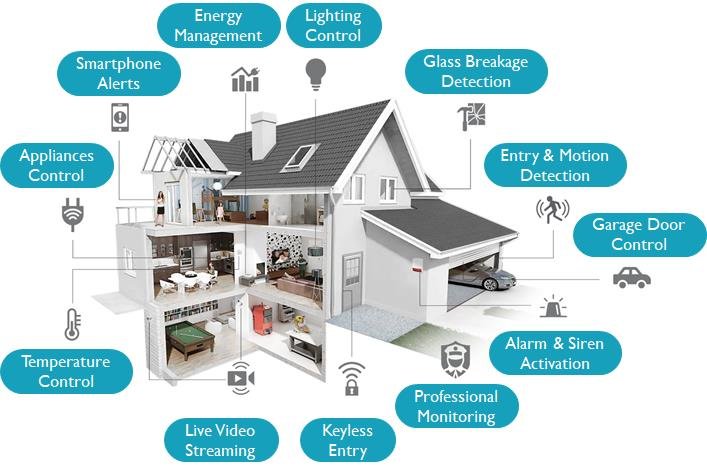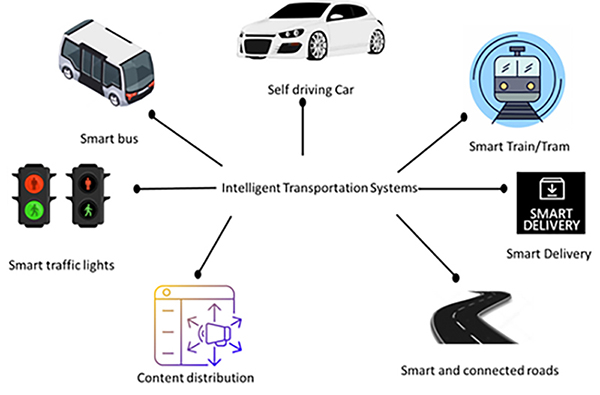
- Introduction
- Smart Homes: The Connected Lifestyle
- Smart Cities: Infrastructure That Thinks
- Healthcare: Saving Lives with Connected Device
- Transportation: Driving Intelligence into Mobility
- Agriculture: Precision Farming with IoT
- The Future of Everyday Living with IoT
- Conclusion
Introduction
The Internet of Things (IoT) is no longer just a buzzword, it’s a living, breathing part of our everyday existence. From the thermostat that adjusts your home temperature before you arrive to wearable fitness trackers that monitor your heart rate in real-time, IoT technology is embedded in countless areas of modern life. IoT refers to a vast network of connected devices that collect, send, and act on data from the environment using embedded sensors, software, and connectivity. These devices can communicate with one another and with us making everyday tasks more convenient, efficient, and insightful. In this blog, we’ll explore five real-life applications of IoT that are actively making everyday living smarter, safer, and more sustainable. The Internet of Things (IoT) is a network of interconnected devices that communicate and exchange data over the internet, Data Science Training enabling smarter and more efficient systems. These devices range from everyday objects like smart thermostats and wearable fitness trackers to industrial machines and connected vehicles. IoT allows real-time monitoring, automation, and data-driven decision-making, transforming how individuals, businesses, and cities operate. By collecting and analyzing vast amounts of data, IoT enhances convenience, productivity, and safety across various sectors, including healthcare, manufacturing, transportation, and agriculture. As technology evolves, IoT continues to expand, creating new opportunities for innovation, connectivity, and intelligent solutions in our increasingly digital world.
Smart Homes: The Connected Lifestyle
Smart homes are perhaps the most visible and widely adopted example of IoT in action. The modern smart home integrates Impact of IoT-enabled devices to automate and enhance home security, comfort, and energy management.
Key IoT Components in Smart Homes
- Smart Thermostats (e.g., Nest, Ecobee): These learn user preferences over time and optimize heating/cooling for comfort and efficiency Scala Certification .
- Smart Lights (e.g., Philips Hue): Controlled via smartphone apps or voice assistants, they adjust brightness and color automatically.
- Voice Assistants (e.g., Amazon Alexa, Google Assistant): Control smart devices, play music, provide weather updates, and more.
- Smart Security Systems (e.g., Ring, Arlo): IoT-powered doorbells, cameras, and motion detectors notify homeowners in real-time and allow remote monitoring Data Science Training.
- Smart Appliances (e.g., refrigerators, washing machines): Alert users when a load is done, when groceries are running low, or even when maintenance is needed.

Do You Want to Learn More About Data Science? Get Info From Our Data Science Course Training Today!
Smart Cities: Infrastructure That Thinks
Cities are complex ecosystems, and IoT is playing a major role in streamlining urban operations. Smart cities integrate IoT sensors and platforms to optimize traffic, improve air quality, manage waste, and conserve energy.
Key IoT Components in Smart Cities
- Smart Traffic Management: Sensors detect real-time congestion and adjust traffic lights accordingly to reduce bottlenecks.
- Smart Parking Systems: Apps help drivers locate available parking spots, reducing time and fuel spent searching Spark SQL .
- Waste Management: Smart bins notify collection crews when they’re full, optimizing pickup schedules and routes.
- Environmental Monitoring: IoT sensors measure air quality, noise levels, and water quality, informing policy and response.
- Energy-Efficient Lighting: Streetlights turn on/off based on ambient light or motion, conserving energy.
- Wearable Health Trackers (e.g., Fitbit, Apple Watch): Monitor heart rate, blood oxygen, steps, sleep quality, and more.
- Remote Patient Monitoring (RPM): Devices transmit real-time vitals to healthcare providers, allowing for early intervention Apache Pig.
- Smart Inhalers and Injectors: Help manage asthma or diabetes by tracking usage and ensuring timely medication.
- Telehealth Integration: IoT tools complement virtual consultations with accurate data.
- Hospital Asset Tracking: RFID and sensors track equipment, staff, and patients, improving workflow and safety.
- Fleet Management Systems: Use GPS, Big Data Career Path fuel sensors, and diagnostics to optimize routes and reduce costs.
- Connected Vehicles: Share real-time data on traffic, road conditions, and mechanical issues.
- Predictive Maintenance: Sensors alert maintenance teams before parts fail, avoiding breakdowns.
- Ride-Sharing Apps (e.g., Uber, Lyft): Match users and drivers, optimize routes, and monitor performance using IoT.
- Smart Public Transport: IoT helps track buses/trains, estimate arrival times, and manage ticketing systems.
- Soil and Moisture Sensors: Monitor real-time soil health and water content, ensuring efficient irrigation.
- Climate Monitoring Devices: Track temperature, humidity, Big Data Analytics and rainfall to optimize planting and harvesting schedules.
- Livestock Monitoring: Wearable devices track animal health, location, and behavior.
- Automated Tractors and Drones: Collect aerial data and apply fertilizers or pesticides with precision.
- Supply Chain Tracking: Monitor crop storage conditions and delivery logistics in real-time.
- Personalized Health Systems: Your home medical devices alert doctors before symptoms arise.
- Autonomous Deliveries: Drones and self-driving vehicles bring groceries and medicine Data Architect Salary
- Hyper-Connected Workspaces: Offices adjust lighting, temperature, and schedules based on employee behavior.
- AI-Powered Home Assistants: Not just reacting to commands, but proactively offering insights and support.
Would You Like to Know More About Data Science? Sign Up For Our Data Science Course Training Now!
Healthcare: Saving Lives with Connected Devices
IoT in healthcare often referred to as the Internet of Medical Things (IoMT) is revolutionizing patient care, diagnostics, Connected Lifestyle and treatment. From wearable devices to smart pills, IoT is enhancing outcomes while reducing strain on healthcare systems.
Key IoT Applications in Healthcare
Transportation: Driving Intelligence into Mobility
IoT is transforming how people and goods move. From connected vehicles to public transport systems, IoT makes travel safer, faster, and more efficient.
Key IoT Applications in Transportation

Gain Your Master’s Certification in Data Science Training by Enrolling in Our Big Data Analytics Master Program Training Course Now!
Transformations and Actions
Feeding a growing global population requires innovation and IoT is delivering it through precision agriculture. By embedding sensors in fields, equipment, and animals, farmers can make informed decisions that boost productivity and sustainability.
Key IoT Applications in Agriculture
Preparing for Data Science Job? Have a Look at Our Blog on Data Science Interview Questions & Answer To Acte Your Interview!
The Future of Everyday Living with IoT
The IoT revolution is still in its early stages. With the expansion of 5G, edge computing, and AI, IoT devices will become faster, smarter, embedded and more ubiquitous. Homes will not just be connected, they’ll be context-aware, adjusting behavior based on habits and preferences.
Future possibilities include:
Conclusion
From the homes we live in to the cities we move through, the food we eat, and the healthcare we receive, the impact of IoT is transforming everyday life. It enables smarter decisions, improves efficiency, and creates opportunities for innovation across sectors. As IoT technology matures, we can expect even more personalized, predictive, and proactive applications that further enhance our daily routines Data Science Training. The future is not just connected, it’s intelligent. Whether you’re a consumer, developer, or business owner, embracing IoT will be key to thriving in an increasingly digital world. The Internet of Things (IoT) is revolutionizing the way we interact with technology, bridging the gap between the physical and digital worlds. By connecting devices, collecting data, and enabling intelligent automation, IoT enhances efficiency, convenience, Connected Lifestyle and decision-making .


